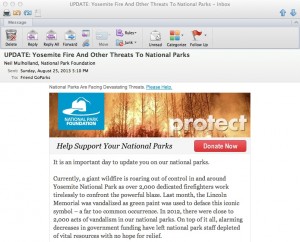“Money in your mailbox” was the mantra of many a get-rich-quick offer in a simpler and sunnier era, promising greedy and gullible people they could run a successful mail order business from home. Simplicity has fallen on hard times, as has the United States Postal Service, and interesting direct mail examples are increasingly rare. But I hit a hot streak recently and will share them with you.
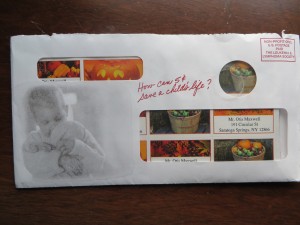
First up is a package that literally has money in it, “How can 5¢ save a child’s life?” from the Leukemia & Lymphoma Association. This is a worthy but small organization and they went to the big agency that makes the address labels and a junior copywriter was assigned to the job. I know the copywriter is junior because they never answer the question!
The letter starts, “I’ve included a nickel to make a point. You and I both know that a single nickel won’t go far in the fight against blood cancers. But even nickels can quickly add up. And if you invest these nickels in blood cancer research that is searching for clues, you could save not only one child but thousands of patients.” Then the nickel is referenced in passing on the ask sheet: “your generous gift, along with this nickel…”
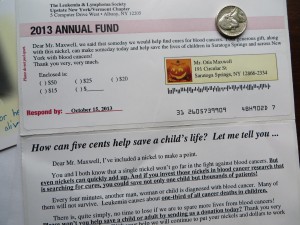
The copywriter wasn’t comfortable with the (probably mandated) concept so they disparage it. No, a nickel really can’t do much. I’m just enclosing it to make a point. But what if they’d told us about one thing that actually does cost a nickel in research and used that as a stepping stone? And said I want you to send as many nickels as you can spare… and keep this one or pass this along and tell another person about the need. Take the time to make the reader think and visualize, instead of going through the motions.
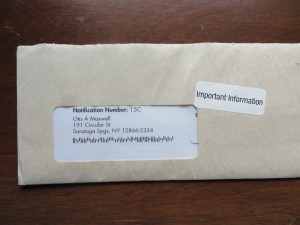
Next up is one of those cleverly art directed packages that you want to open out of curiosity. What’s new is the peel off sticker next to the window that says “important information”. It looks like somebody working at their desk literally printed that off from a sheet of Avery labels and stuck it on the package. The placement of the sticker calls attention to a plastic card inside, its corner just visible through the envelope window. So I have to open it and discover… it’s a “proof of special invitation status” from Discover. They want me to take out a personal loan; if I was in the market for a loan they certainly would have gotten my attention.
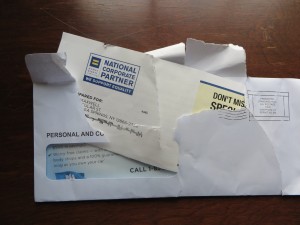
There’s a story behind the next package, another anonymous package which has been torn into pieces. My 11 year old asked why I was recycling this without opening it and I pointed out the clues: “personal and confidential” but with a standard mail indicia indicates it’s a piece of junk mail. But he insisted on opening it (by ripping it apart). And lo and behold, it’s an affinity offer to supporters of Human Rights Council, a LGBT political action group. It’s not that long ago that all mail referencing the recipient’s LGBT status was delivered anonymously to protect their privacy but I am going to guess that any HRC member today would be proud to announce their affiliation. This is one anonymous mailing that should NOT have been anonymous; Nationwide Insurance could have multiplied their response by putting something simple like “A special announcement to HRC supporters” on the OE. But I’m guessing this is a standard format that is used by Nationwide for all kinds of affinity groups so that possibility never even crossed their mind.
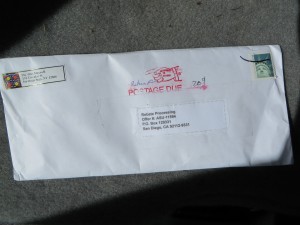
Finally, a word about the sheer incompetence of the USPS which has to be a factor in the decline of direct mail. Back in the day when I was direct mail manager for a department store, we had to hire a “postal consultant” because it was impossible to communicate with the post office directly about the most efficient and cost effective ways to make sure our mail got through. Time and time again, the USPS has shot itself in the foot with oblique self-serving practices when it could have thrived if it treated itself like the business it claims to be.
This envelope is an example. It was rejected and returned “postage due” 3 weeks after mailing. It’s not overweight, so I took it to my local post office and asked for an explanation. They said it’s probably because of the cardboard square inside, the UPC from a product box, which I was returning for a rebate. It made the envelope “non machinable” and when it got stuck in the automated feeder it was kicked out, where it sat in a pile for a few weeks till somebody processed it. Turns out there is a 20 cent surcharge for “mail containing a rigid object”. Bet you didn’t know that. Metal’s obviously rigid, but what about a piece of cardboard? I guess if the automated equipment rejects it, it’s rigid. The machines have taken over; too bad they’re not more discerning.
